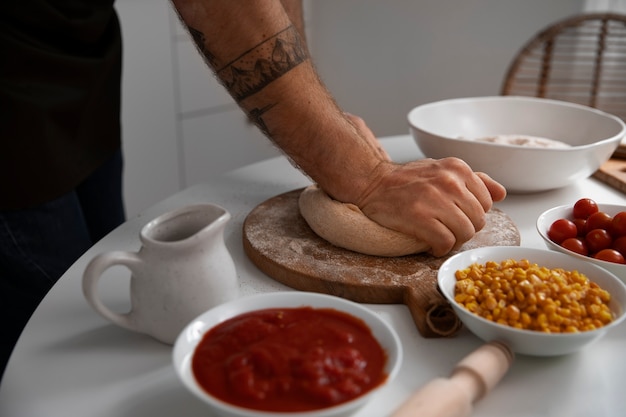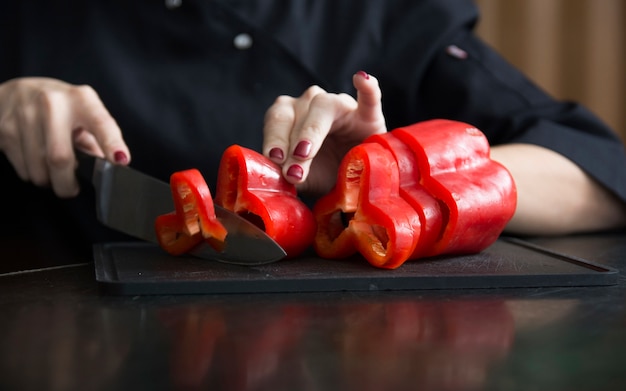(Part 1) - The World of Italian Sausage

Before we get into the nitty-gritty of cooking times, let's first understand the different types of italian sausage we might encounter. This is crucial because different sausages have different fat content, casings, and flavours, all of which impact the cooking time and the final taste.
1. sweet italian sausage
This is the classic Italian sausage, often made with pork and a blend of spices like fennel and garlic. It's typically milder than other types and is perfect for everything from sandwiches to pasta dishes. Think of it as the "gateway sausage" for those new to Italian flavours.
2. hot italian sausage
This sausage packs a bit more punch thanks to the addition of red pepper flakes. It's a great choice if you like a little kick, and it's particularly delicious in pasta sauces and pizzas. It's got a bit of heat but isn't overwhelmingly spicy.
3. spicy italian sausage
This is a spicier version of the hot sausage, using more red pepper flakes or other hot peppers. It's for those who truly love the heat. This one is not for the faint of heart!
4. Italian Sausage Links
These are usually made with a blend of pork and beef, and they're often sold in casings. They're great for grilling, baking, or frying. They're perfect for those who want a sausage that holds its shape.
5. Italian Sausage Bulk
This is sausage meat that's not in a casing. It's perfect for making meatballs, pasta sauces, or stuffing. It's very versatile and easy to work with, especially for those who like to customize their recipes.
(Part 2) - Getting the Temperature Right

Now, onto the crucial bit: temperature. You can't just chuck your sausage into a pan and hope for the best, you need to pay attention to the internal temperature. You want it cooked through but not overcooked. That magic number is 160°F (71°C). This ensures that any potential bacteria are destroyed, and your sausage is safe to eat.
We're going to talk about the different cooking methods and the best ways to monitor those temperatures, so don't worry, we'll get you to sausage-cooking nirvana.
(Part 3) - Cooking Italian Sausage in a Pan

This is the most basic way to cook sausage, and it's a great option if you're short on time. It's also a great way to get a nice crispy exterior and a juicy interior. Here's how to do it:
- Heat a large skillet over medium heat. A good quality, heavy-bottomed skillet will ensure even heat distribution and prevent scorching.
- Add a little bit of oil to the skillet. Use a neutral oil like vegetable oil or canola oil. Don't be shy with the oil, a little bit goes a long way.
- Place the sausages in the skillet and cook, turning them occasionally, until they're browned on all sides. This will create a lovely crust on the outside. Don’t overcrowd the pan, give the sausages some space to brown evenly.
- Reduce heat to low and continue cooking, turning the sausages occasionally, until they reach an internal temperature of 160°F (71°C). Be patient, the internal temperature is crucial for safety and a perfect texture.
Cooking time for sausages in a pan will vary depending on the type of sausage, the size of the sausage, and how many you're cooking. But, generally, it should take about 10-15 minutes for small sausages and 15-20 minutes for larger ones.
A little tip from my own kitchen: you can always use a meat thermometer to check the internal temperature of the sausage. It's the most accurate way to ensure it's cooked through. Just insert the thermometer into the thickest part of the sausage, making sure to avoid any bones.
(Part 4) - Grilling Italian Sausage
Grilling sausage is a great way to add a smoky flavour and create a beautiful char. It's perfect for outdoor gatherings and summertime meals. Here's how to do it:
- Preheat your grill to medium heat. A hot grill will sear the outside quickly, but you need to be careful to avoid burning the sausage.
- Place the sausages on the grill and cook, turning them occasionally, until they're browned on all sides. Aim for nice grill marks and a golden brown colour.
- Reduce heat to medium-low and continue cooking, turning the sausages occasionally, until they reach an internal temperature of 160°F (71°C). This is where patience comes in, let the sausage cook slowly and evenly.
The cooking time for sausages on the grill will vary depending on the size of the sausage and the heat of your grill. But, generally, it should take about 15-20 minutes.
A tip for grilling: if you’re using sausage links, try skewering them before grilling. It helps them stay together and prevents them from falling apart.
(Part 5) - Baking Italian Sausage
Baking is a great way to cook a batch of sausage without having to stand over the stove. It's also a great option for cooking sausage in bulk, and you can even add vegetables for a complete meal. Here's what you need to do:
- Preheat your oven to 375°F (190°C). A hot oven ensures that the sausage cooks quickly and evenly.
- Place the sausages on a baking sheet. Line the baking sheet with parchment paper or foil to make clean up a breeze.
- Bake the sausages for about 20-25 minutes, turning them over halfway through, until they reach an internal temperature of 160°F (71°C). Turning them ensures even cooking and a crispy exterior.
A little tip for baking: you can add vegetables to the baking sheet, like onions, peppers, or zucchini. The sausage fat will render out and season the veggies beautifully.
(Part 6) - Cooking Italian Sausage in a slow cooker
For the ultimate in convenience, there’s the slow cooker. It's perfect for those busy nights when you want a delicious meal without much fuss. Here’s how to use it:
- Place the sausages in the slow cooker and cook on low for 4-6 hours, or on high for 2-3 hours, until they reach an internal temperature of 160°F (71°C). slow cooking allows the sausage to become incredibly tender and flavorful.
A tip for slow cooking: don't overfill the slow cooker. You want to make sure the sausages have enough space to cook evenly.
(Part 7) - Knowing When It’s Done: The Signs of a perfect sausage
Now, how do you know when your sausage is cooked through? The best way is to use a meat thermometer. However, here are a few visual cues that can help you determine if your sausage is ready:
- The sausage will be firm to the touch. It will feel solid and not mushy.
- The juices will run clear when you pierce the sausage with a fork. The juices should be clear and not pink, indicating that the meat is cooked through.
- The sausage will be browned on all sides. This indicates that the outside has been cooked thoroughly.
If you're not sure, it's always better to err on the side of caution and cook it a little longer. It's worth sacrificing a few minutes rather than risking an undercooked sausage.
(Part 8) - Italian Sausage Cooking Times: A Cheat Sheet
To make it easier for you, here’s a table with some estimated cooking times:
| Method | Cooking Time |
|---|---|
| Pan-frying | 10-15 minutes (small sausages), 15-20 minutes (large sausages) |
| Grilling | 15-20 minutes |
| Baking | 20-25 minutes |
| Slow Cooking | 4-6 hours (low), 2-3 hours (high) |
Remember, these are just estimates, and cooking times will vary depending on the type of sausage and the size of your batch.
(Part 9) - Tips for Cooking Italian Sausage: From My Kitchen to Yours
Now, let's talk about some tips to make your sausage cooking experience even better. These tips come from years of my own culinary experimenting, and they're designed to help you create the most delicious sausage possible.
- Don't overcrowd the pan. If you add too many sausages to the pan at once, they won't cook evenly. Give them room to breathe!
- Don't puncture the casings. This can cause the sausage to lose its juices. Leave those casings intact for a juicy, flavourful sausage.
- Use a meat thermometer. This is the most accurate way to ensure that the sausage is cooked through. Don't rely solely on visual cues, a thermometer is your best friend.
- Don't overcook the sausage. Overcooked sausage will be dry and tough. Cook it just until it's done, no more!
- Let the sausage rest. After cooking, let the sausage rest for a few minutes before slicing or serving. This will allow the juices to redistribute, resulting in a juicier sausage.
- Experiment with different spices. You can add your own unique touch to your sausage by adding different spices and herbs.
(Part 10) - Delicious Italian sausage recipes: From Classic to Creative
Now that you know the ins and outs of cooking sausage, it's time to put that knowledge to use! Here are a few of my favourite recipes that showcase the versatility of Italian sausage:
- Classic Italian Sausage and Peppers: This is a simple yet delicious dish that's perfect for weeknight meals. Simply saute the sausage with onions and peppers until they're tender and serve over pasta or rice. You can even add a little bit of tomato sauce for extra flavour.
- Italian Sausage Pizza: Sausage makes an incredible pizza topping. You can use it on its own or combine it with other toppings like onions, peppers, and mushrooms. It adds a savoury, meaty flavour to any pizza.
- Italian Sausage Soup: This hearty soup is perfect for cold weather. You can use any type of Italian sausage in this recipe, but I prefer sweet Italian sausage for its milder flavour. It’s a comforting and satisfying meal.
- Italian Sausage stuffed peppers: This is a great way to use up leftover sausage. Simply stuff bell peppers with a mixture of sausage, rice, and vegetables and bake until the peppers are tender. It's a colourful and flavourful dish.
- Italian Sausage and Potato Hash: This is a hearty and satisfying breakfast dish. Simply saute the sausage with potatoes, onions, and peppers until they're tender and crispy. It’s a great way to start your day.
- Italian Sausage Pasta with Creamy Tomato Sauce: This is a classic Italian dish that is both comforting and flavorful. You can use any type of Italian sausage in this recipe, but I prefer sweet Italian sausage for its mild flavor. It's a perfect example of how Italian sausage can be a key ingredient in a sophisticated dish.
These are just a few ideas to get you started. There are endless possibilities when it comes to cooking with Italian sausage!
FAQs
Still have questions? You're not alone. Here are some of the most common questions I get about cooking Italian sausage:
1. Can I cook Italian sausage without the casing?
Absolutely! You can cook Italian sausage without the casing, but you’ll want to break it up into smaller pieces. It’s fantastic for making pasta sauces, stuffing, and meatballs. It’s a great way to add extra flavor and texture to your dishes.
2. How can I tell if Italian sausage is bad?
Like any meat, you need to be aware of the signs of spoilage. Look for any discoloration, a slimy texture, or a foul smell. If you see any of these signs, it’s best to throw the sausage away. It’s not worth the risk of food poisoning!
3. Can I freeze Italian sausage?
Yes, you can freeze Italian sausage. It's best to freeze it in its original packaging or wrap it tightly in plastic wrap. You can freeze it for up to 3 months. It’s a great way to have sausage on hand for quick meals.
4. What can I do with leftover Italian sausage?
Leftover sausage is amazing! You can use it in a variety of dishes, such as pasta sauces, soups, stews, sandwiches, and even breakfast burritos. It’s a great way to prevent food waste and add extra flavor to your meals.
5. Is Italian sausage healthy?
It’s important to remember that Italian sausage is a processed meat. It’s usually high in fat and sodium, so it's best to enjoy it in moderation. But, it's also a good source of protein and iron, which are important nutrients.
There you have it! That's your ultimate guide to Italian sausage. Now go forth and cook up a storm!
Everyone is watching

Corn on the Cob: The Ultimate Guide to Perfectly Cooked Ears
Healthy MealsAh, corn on the cob. Just the name evokes images of sunny days, barbecues, and that sweet, juicy flavour that ...

Perfect Pork Roast Oven Cooking Time: A Guide to Delicious Results
Healthy MealsThere's something truly satisfying about a perfectly roasted pork. The aroma alone is enough to make your mout...

Ham Cooking Time: How Long to Bake, Smoke, or Boil a Delicious Ham
Healthy MealsAh, ham. It's a classic, isn't it? A real crowd-pleaser, especially around holidays. And when done right, it'...

Scallops: The Ultimate Guide to Perfect Cooking
Healthy MealsAh, scallops. Those delicate, sweet, and utterly delicious morsels of the sea. They hold a special place in my...

Spaghetti Squash: The Ultimate Guide to Cooking and Serving
Healthy MealsRemember that time you saw spaghetti squash at the supermarket, looking all bumpy and strange, and thought, "W...
